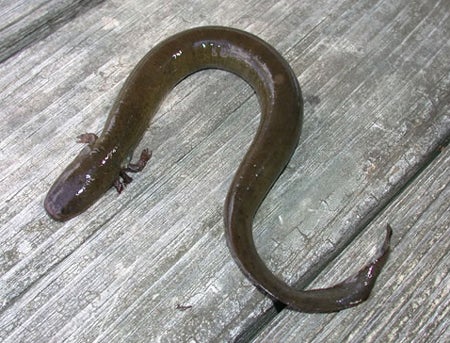SCIENTIFIC NAME:
Siren intermedia spp.
Siren intermedia intermedia - Eastern Lesser Siren
Siren intermedia nettingi - Western Lesser Siren
OTHER NAMES: Eastern lesser siren, western lesser siren
STATUS:
Eastern lesser siren: Common. Widespread in Coastal Plain. Intergradation with S.i. nettingi (western lesser siren) in western portion of Coastal Plain. Lowest Conservation Concern.
Western lesser siren: Isolated records in western portions of Coastal Plain. Similar to S.i. intermedia but slightly larger and different costal groove count. Intergrades with S.i. intermedia. MODERATE CONSERVATION CONCERN.
DESCRIPTION: This small eel-like salamander ranges from 7 to 19 inches in length. They are usually some form of gray to bluish black, and have two small forelegs tucked behind external gills. Four toes are found on each foreleg. Lighter specimens often have small dark spots along the head and dorsum. Juveniles have a red band along the snout and side of head.
DISTRIBUTION: From North Carolina south along the coastal plain into east Texas, northward up the Mississippi River Valley into Illinois and Indiana. In Alabama, south of the Fall Line Hills region. Both subspecies intergrade along west central Alabama.
HABITAT: This small aquatic salamander prefers swamps and shallow wetlands with abundant vegetation.
FEEDING HABITS: Lesser sirens rely heavily on aquatic arthropods and worms. Small amounts of vegetation have been found in the digestive tracts of some individuals.
LIFE HISTORY AND ECOLOGY: Little is known about the breeding habits of this small salamander. Few accounts exist, but suggest they breed in late winter and early spring. They have the ability to burrow into the mud during times of drought, and excrete a substance that encapsulates their entire body, except the nose and mouth. Upon the arrival of rain, they will resume normal activity.
REFERENCES:
Conant, Roger. 1975. A Field Guide to Reptiles and Amphibians of Eastern and Central North America. Houghton Mifflin Co., Boston, MA. 442-443 pp.
Mount, Robert H. 1996. The Reptiles & Amphibians of Alabama. The University of Alabama Press. Tuscaloosa, AL. 144-145 pp.
AUTHOR: Matt Brock, Wildlife Biologist, Division of Wildlife and Freshwater Fisheries






